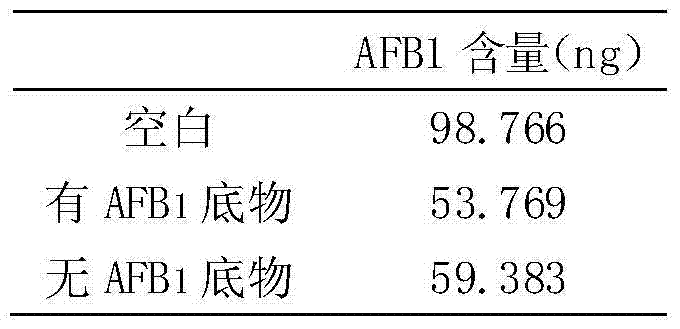Bacillus amyloliquefacien for degrading aflatoxin B1 in peanut meal
A technology for dissolving starch spores and aflatoxins, applied in the field of applied microorganisms, can solve the problems of few industrial application studies, limited to the laboratory research stage, etc., and achieve the effects of high industrial application value, increased nutritional value, and convenient operation.
- Summary
- Abstract
- Description
- Claims
- Application Information
AI Technical Summary
Problems solved by technology
Method used
Image
Examples
Embodiment 1
[0022] The characteristic of embodiment 1 bacillus amyloliquefaciens CGMCC NO.9021
[0023] (1) Easier to cultivate
[0024] The colony of Bacillus amyloliquefaciens on the broth agar medium is irregular in shape, wrinkled, irregular in edge, off-white, with a raised center, and the colony is sticky. White wrinkle forms when grown in broth. Gram staining was positive, and there were spores in the central part of the bacteria. Cultured in broth medium for 12h can quickly reach 10 9 CFU / mL, and the medium formula is simple, industrial application will be more economical and practical.
[0025] (2) Can inhibit the growth of Aspergillus flavus
[0026] Bacillus amyloliquefaciens significantly inhibits the growth of Aspergillus flavus (such as Aspergillus flavus CGMCC No.3.4408, CGMCC No.3.4410) during the growth process, reducing aflatoxin B from the source 1 produce. Such as figure 1 As shown, Bacillus amyloliquefaciens grows around the filter paper sheet, and the yellow-g...
Embodiment 2
[0033] Example 2 Bacillus amyloliquefaciens CGMCC NO.9021 to low content aflatoxin B in peanut meal 1 Degradation
[0034] Pick the Bacillus amyloliquefaciens on the slant and place them in the broth medium, perform primary activation for 24 hours at 37°C and 200r / min shaking conditions, and then pass through the broth medium containing 3% (m / v) peanut meal for second Grade expansion training for 12 hours. will be contaminated with aflatoxin B 1 The peanut meal sample was pulverized, dried, accurately weighed 50g, added to a 250mL fermentation bottle, and sterilized by high-pressure steam. Add the Bacillus amyloliquefaciens seed solution of the secondary expansion culture to the cooled peanut meal with 10% (v / w) inoculation amount, adjust the ratio of material to water to 1:0.8, stir evenly under sterile conditions, and use it on the bottle mouth 8 layers of gauze wrap. The inoculated fermentation bottle was placed in a constant temperature incubator at 37° C. for 72 hours...
Embodiment 3
[0036] Example 3 Bacillus amyloliquefaciens CGMCC NO.9021 on high content of aflatoxin B in peanut meal 1 Degradation
[0037]Pick the Bacillus amyloliquefaciens on the slant and place them in the broth medium, perform primary activation for 24 hours at 37°C and 200r / min shaking conditions, and then pass through the broth medium containing 3% (m / v) peanut meal for second Grade expansion training for 12 hours. will be contaminated with aflatoxin B 1 The peanut meal sample was pulverized, dried, accurately weighed 50g, added to a 250mL fermentation bottle, and sterilized by high-pressure steam. Add the Bacillus amyloliquefaciens seed solution of the secondary expansion culture into the cooled peanut meal with 10% inoculum amount and 1:0.8 material-to-water ratio, stir evenly under aseptic conditions, and wrap the mouth of the bottle with 8 layers of gauze. The inoculated fermentation bottle was placed in a constant temperature incubator at 37° C. for 72 hours of fermentation,...
PUM
 Login to View More
Login to View More Abstract
Description
Claims
Application Information
 Login to View More
Login to View More - R&D
- Intellectual Property
- Life Sciences
- Materials
- Tech Scout
- Unparalleled Data Quality
- Higher Quality Content
- 60% Fewer Hallucinations
Browse by: Latest US Patents, China's latest patents, Technical Efficacy Thesaurus, Application Domain, Technology Topic, Popular Technical Reports.
© 2025 PatSnap. All rights reserved.Legal|Privacy policy|Modern Slavery Act Transparency Statement|Sitemap|About US| Contact US: help@patsnap.com



